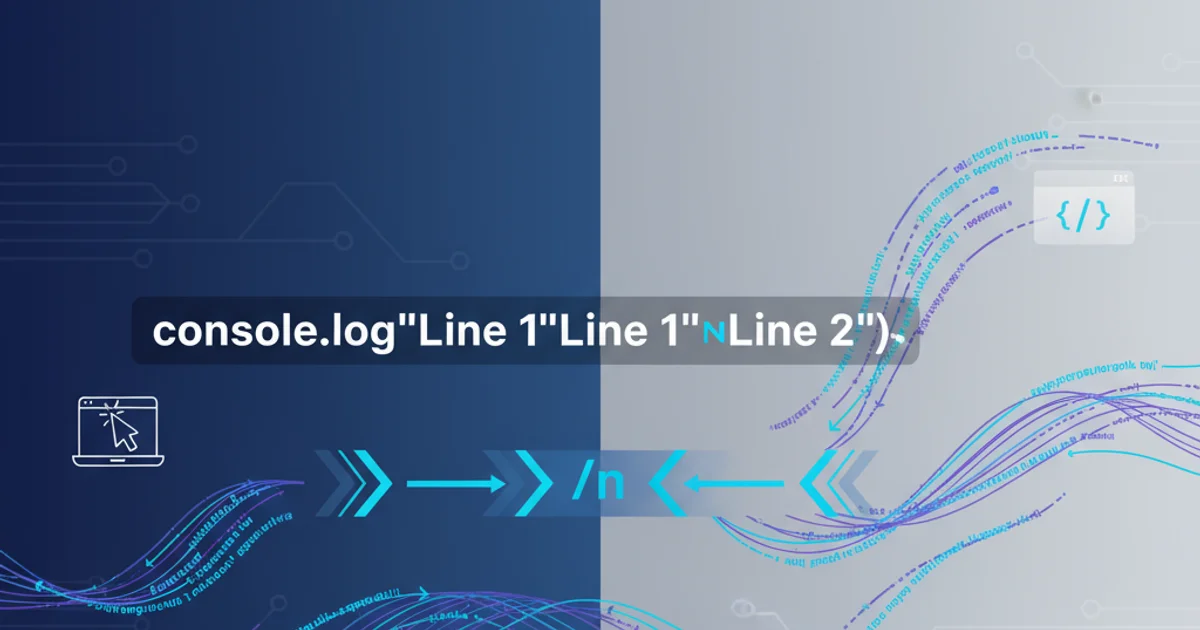What is the JavaScript string newline character?
Categories:
Understanding JavaScript Newline Characters

Explore the various ways to represent newline characters in JavaScript strings, their differences, and how to use them effectively for formatting text.
In JavaScript, a newline character is a special control character that signifies the end of a line of text and the beginning of a new one. This is crucial for formatting output, especially when working with multi-line strings, console logs, or rendering text in HTML elements. Understanding how to correctly use and identify newline characters is fundamental for any JavaScript developer.
The Primary Newline Character: \n
The most common and universally accepted newline character in JavaScript is the escape sequence \n. This character represents a 'line feed' (LF) and is the standard way to insert a new line across most operating systems (Unix-like systems, macOS) and programming environments. When JavaScript encounters \n within a string, it interprets it as an instruction to move the cursor to the next line.
const multiLineString = "Hello World!\nThis is a new line.\nAnd another one.";
console.log(multiLineString);
// Expected output:
// Hello World!
// This is a new line.
// And another one.
Using \n to create multi-line output in the console.
\n is widely used, remember that in some older Windows environments, the newline might be represented by \r\n (carriage return followed by line feed). However, JavaScript's \n generally handles cross-platform compatibility well in most modern contexts.Template Literals for Multi-line Strings
Introduced in ECMAScript 2015 (ES6), template literals (also known as template strings) provide a more convenient and readable way to create multi-line strings without explicitly using \n. By enclosing text within backticks (`), you can simply press Enter to create new lines directly within the string literal, and JavaScript will automatically interpret these as \n characters.
const templateLiteralString = `This is the first line.
This is the second line.
This line is indented.`;
console.log(templateLiteralString);
// Expected output:
// This is the first line.
// This is the second line.
// This line is indented.
Creating multi-line strings using template literals.
flowchart TD
A[Start String Definition] --> B{Is it a template literal?}
B -- Yes --> C[Use backticks (` `)]
C --> D[Press Enter for new line]
D --> E[JavaScript interprets as \n]
B -- No --> F[Use single/double quotes]
F --> G[Explicitly add \n]
G --> E
E --> H[End String]Decision flow for defining multi-line strings in JavaScript.
Other Newline-Related Characters: \r and \r\n
While \n is dominant, it's worth understanding \r (carriage return) and the combination \r\n.
\r(Carriage Return): Historically,\rmoved the cursor to the beginning of the current line without advancing to the next. In modern contexts, it's rarely used alone for newlines in JavaScript.\r\n(Carriage Return + Line Feed): This combination is the standard newline sequence on Windows operating systems. While JavaScript's\noften suffices, you might encounter\r\nwhen dealing with text files originating from Windows or when parsing certain network protocols. When writing cross-platform code, it's often best to normalize newlines if you're processing external text.
const windowsNewline = "Line 1\r\nLine 2 (Windows style).";
console.log(windowsNewline);
const mixedNewlines = "Hello\nWorld\r\nJavaScript";
console.log(mixedNewlines);
// To normalize newlines to \n:
const normalizedString = mixedNewlines.replace(/\r\n|\r/g, '\n');
console.log(normalizedString);
Demonstrating \r\n and normalizing newlines.
\r\n while a string from a Unix-like system will use \n. Always normalize newlines (e.g., using string.replace(/\r\n|\r/g, '\n')) before comparison or processing if cross-platform consistency is critical.